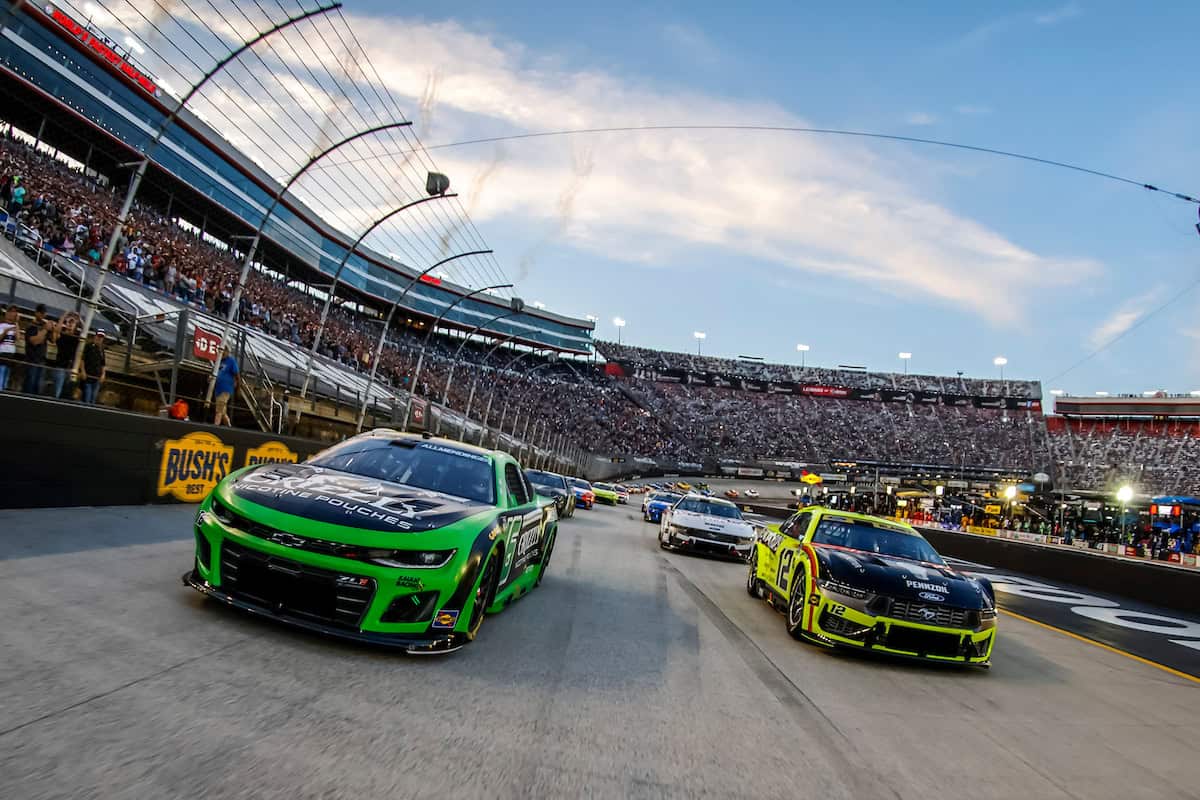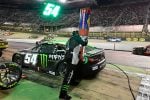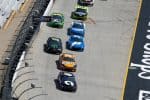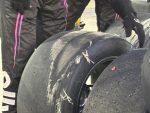In the past, the Night Race at Bristol Motor Speedway stood alone on the Cup Series schedule.
Seriously. From 1985 to 1990, it was the only night race on the calendar. That changed after lights were added at Richmond Raceway and Charlotte Motor Speedway in the early 90s.
Nowadays, night racing at Bristol is still a draw, but the Next Gen car has hurt the on-track product significantly. The last two Bristol Cup races prior to this past weekend had a grand total of 12 lead changes, and Kyle Larson led 873 of the 1,000 laps en route to winning both.
Goodyear took some steps to try to alleviate this lack of action with what was apparently the softest right-side tires ever brought to the track. It seemed on Friday afternoon that it wasn’t going to work. Obviously, that wasn’t the case 24 hours later.
With the Bristol races in recent years and the Martinsville races in the spring, the whole thing surrounding this situation has been track temperature. The key is that there is a crossover point. Above that temperature (approximately 88°), the track will take rubber, and it’ll be like a regular race. If it doesn’t get there (or drops below the threshold), you’re looking at sketch city.
At Martinsville, it usually isn’t that bad and doesn’t change the race much. At Bristol, it absolutely does.
Saturday night was sketch city from the very start. Here’s the thing about that: I feel that if NBC Sports truly considered it to be a big story, they would have led Countdown to Green with it or would have at least gave it some coverage during pre-race instead of almost exclusively focusing on the playoff cutoff. Based on their actions, they seemingly thought it wasn’t going to be a thing.
Oh, how wrong they were. Jeepers. Knowing what I knew, I would have wanted track temperature readings during pre-race coverage. We didn’t get any until lap 63 of the race. By that point, it was already utter chaos.
As early as lap 15, I was wondering when they were going to cover the tire story. Remember, NASCAR and Goodyear seemingly wanted this to happen.
This broadcast was literally the exact opposite of FOX Sports 1’s coverage of this year’s Food City 500. Back then, FOX Sports played up the potential for chaos, then got the exact opposite when temperatures warmed up enough to prevent the tire issues.
FOX Sports also failed to provide track temperatures in a timely fashion. They did a little earlier than NBC Sports did, but it was still too late. The question had already been answered by that point.
On lap 63, it was revealed that the track temperature had slipped to 75°, which was likely only a few degrees warmer than the air temperature at the track. That was low enough for rubber not to stick. It only dropped from there into the 60s.
If anything, this might have been worse that last year’s spring race. Teams were ripping up their right front tires in as little as 25 laps.
With the tire issues squarely in play, the broadcast shifted tones in order to properly cover the issue. We saw some truly nasty-looking tires come off of Ryan Preece and AJ Allmendinger’s cars at the start. Allmendinger was likely the first to have problems, as he dropped off the pace right after losing the lead to Ty Gibbs on lap 24.
Speaking of Gibbs, he proved to be darn near the best driver out there in this circumstance last year. As a result, it wasn’t really a surprise to see him out front. Denny Hamlin was up there last year, as was the now-retired Martin Truex Jr.
Could he have won the race had he not screwed up when trying to make his final stop under green? Quite possibly. We’ll never know for sure.
NBC Sports sought out representatives from Goodyear to get some information about what we were seeing. It seemed crazy that Justin Fantozzi, Goodyear’s operations manager for global race tires, effectively said, “The industry has asked for this … we’re delivering on exactly what we were asked to do,” but that was the truth. The chaos was specifically asked for, more or less to prevent what happened in this race last year.
With the wild tire issues came an increase in passing. According to NASCAR’s Loop Data, it was more than double the average passes that we saw as compared to last year (10.7 per lap as opposed to 4.9). That comes with a couple of caveats. One is the fact that there were 101 fewer laps under green as compared to last year (not a joke). Another is that there was a bunch of pitting under green since the tires just couldn’t go long, whereas last year’s race mostly had pitting under caution.
Despite that, there was still some good action to be had. Everyone was fighting for the inside, so there was a fair amount of jostling. There was side-by-side racing at times. USA Network did make use of the split-screen at times. Yes, it was used more than last year.
That said, I also noted last year that there was more action that could have been shown, but that a good amount of that action didn’t play into the existing storylines. Last year’s race had playoff drivers comprise seven of the top 10 finishing positions, while Saturday night’s race had five in the top 10.
While yes, Bubba Wallace was able to get himself into the top-five last year, that race was never really in doubt. Saturday night’s race was, so you got a more inclusive broadcast. If you checked out Friday Faceoff last week, you probably have a decent idea of what I think about how the playoffs affect race broadcasts. It’s not positive.
Saturday night also saw the Cup Series pit reporting debut of Trevor Bayne. While Bayne has a decent amount of TV experience from his time working with FOX Sports on ARCA broadcasts and in the studio before FOX Sports scrapped it, he’s fairly green in the pits. For someone with a lack of experience, I thought that he did fairly well. He’ll need more reps, but if he wants to do more pit reporting, I would not be opposed.
You ended up with extremes at Bristol. Last year’s Night Race was the fastest Cup race ever run at Bristol Motor Speedway. Saturday night’s race was the slowest Cup race at Bristol since 1974 and the fourth slowest overall. It also set a modern era record for laps under caution with 137 (including an 18-lap yellow when Chase Elliott crashed).
Why were the yellows so long? It likely had to do with NASCAR sending the sweepers out during every caution, which prolonged them. I understand the move since that would decrease the likelihood of someone wiping out on the detritus, which didn’t really happen all night. It just made the race take forever.
Speaking of that, USA Network’s timeslot was designed around last year’s race. This race took 71 minutes longer to run. As a result, they were already over the slot for post-race by the time it ended.
Despite that fact, viewers still got a decent amount of post-race coverage. That said, much of that coverage was based around the playoff cutoff even though that really wasn’t the biggest story of the night.
Overall, NBC Sports seemed to not really plan for tires to dominate the race. This is even though Goodyear had already been touting how soft their tires were going to be. It’s like they saw what happened in practice Friday (mind you, that was in the heat of the day) and assumed that it wasn’t going to be a factor.
Quite simply, they goofed. Luckily, they were able to change on the fly so as to not look completely foolish. The debuting Bayne took the lead here.
The on-track product due to the tires was wacky, but enjoyable to watch. A lot to follow, though.
That’s all for this week. Next weekend, the NASCAR Cup Series begins the Round of 12 at New Hampshire Motor Speedway for their first fall race in New England since 2017. They’ll be joined by the NASCAR Craftsman Truck Series (their first race there since 2017) and the NASCAR Whelen Modified Tour in an early matinee. In addition, Formula 1 will make their annual trip to Azerbaijan while IMSA will be at the Indianapolis Motor Speedway. TV listings can be found here.
In next week’s edition of Couch Potato Tuesday here at Frontstretch, we’ll cover Sunday’s Mobil 1 301 from Loudon. We’ll also discuss the on-demand options you have for Cup races during the NBC Sports portion of the season. The Critic’s Annex will cover Thursday night’s doubleheader for the Truck Series and ARCA.
If you have a gripe with me, or just want to say something about my critique, feel free to post in the comments below. Even though I can’t always respond, I do read your comments. Also, if you want to “like” me on Facebook or follow me on Twitter, please click on the appropriate icons. If you would like to contact either of NASCAR’s media partners, click on either of the links below.
As always, if you choose to contact a network by email, do so in a courteous manner. Network representatives are far more likely to respond to emails that ask questions politely rather than emails full of rants and vitriol.
Phil Allaway has three primary roles at Frontstretch. He's the manager of the site's FREE e-mail newsletter that publishes Monday-Friday and occasionally on weekends. He keeps TV broadcasters honest with weekly editions of Couch Potato Tuesday and serves as the site's Sports Car racing editor.
Outside of Frontstretch, Phil is the press officer for Lebanon Valley Speedway in West Lebanon, N.Y. He covers all the action on the high-banked dirt track from regular DIRTcar Modified racing to occasional visits from touring series such as the Super DIRTcar Series.






